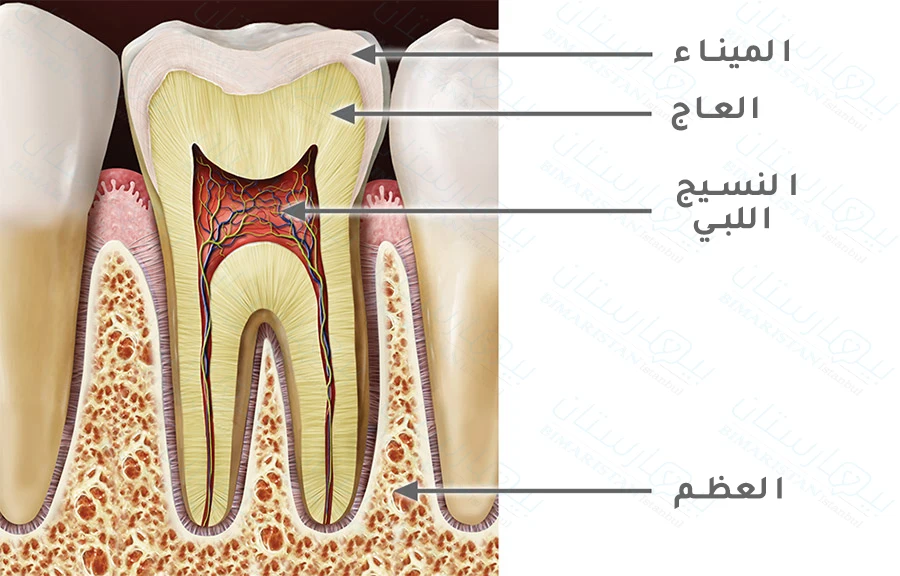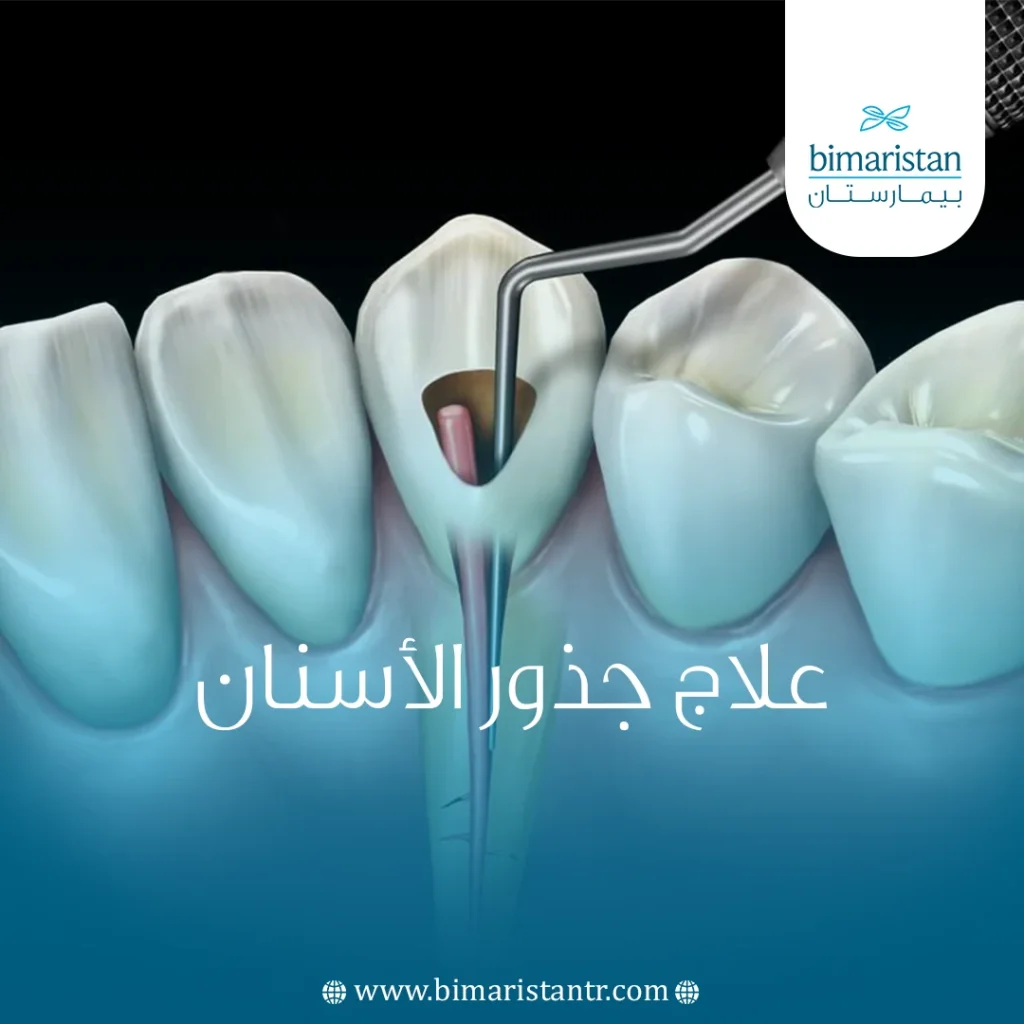علاج جذور الأسنان في تركيا المعروف أيضاً باسم العلاج اللبي هو علاج يتم إجراؤه في القناة الجذرية للسن بهدف السيطرة على العدوى وحماية الاسنان من الالتهابات.
عادة مايطلق العامة على هذه العملية بإزالة العصب وهو علاج بديل للخلع للاحتفاظ بالسن، ويُعتقد أنه إجراء مؤلم للغاية ولكنه في الحقيقة علاج يخفف الآلام الناتجة عن التهابات أعصاب الأسنان.
علاج جذور الأسنان Root canal treatment
علاج قناة الجذر هو علاج يستخدم في حال إصابة اللب السني أو موت عصب الأسنان يتم فيه إزالة النسج اللبية المتضررة ووضع حشوة مكانها.
يتألف السن من تاج وجذر واحد أو أكثر، يقع التاج بشكل رئيسي فوق اللثة بينما تقع الجذور تحتها وتقوم الجذور بربط السن بعظم الفك، يتوضع عصب السن أو لب السن في تاج السن وقناة الجذر ضمن الجزء المجوف من السن الذي يحتوي على الأنسجة العصبية والأوعية الدموية والخلايا الأخرى.

يغذي اللب الأسنان ويوفر الرطوبة للمواد المحيطة وتستجيب الأعصاب في اللب للتغيرات الحرارية المختلفة بإحساس الألم.
ما هي خطوات علاج جذور الأسنان في تركيا؟
يتم علاج جذور الأسنان في عدة خطوات ويستغرق ما بين جلسة وثلاث جلسات حتى يكتمل:
التخدير
سيتم حقن مخدر موضعي في لثتك لتخدير السن المصابة، قد تشعر بألم أو حرقان لكن هذا سيمر بسرعة.
ستظل مستيقظاً أثناء علاج جذور الأسنان لكن المخدر سيمنعك من الشعور بأي ألم.
تنظيف قناة الجذر
لمعالجة الجذور والاعصاب الميتة سيقوم طبيب الأسنان بإزالة كل ما هو داخل قناة الجذر بعد وضع المريض تحت تأثير التخدير الموضعي، وذلك من خلال فتح حجرة اللب السني عن طريق عمل فتحة وصول صغيرة على سطح السن ومن ثم إزالة الأنسجة اللبية المريضة والميتة بأدوات صغيرة جداً تدعى بالمبارد والموسعات.

الحشو المؤقت
سينهي طبيب الأسنان الإجراء عن طريق ملء الفتحة الصغيرة في الجزء العلوي من السن بمادة حشو مؤقتة يساعد هذا العازل على منع تلف القنوات بسبب اللعاب ريثما يتم الإنتهاء من تنظيف قنوات الجذور خلال الجلسات.
حشي قناة الجذر
بعد أن يقوم طبيب الأسنان بالنفوذ إلى وتنظيف المنطقة المجوفة في الضرس التي تدعى بقناة العصب وتشكيلها وتطهيرها باستخدام المبارد والموسعات وسوائل إرواء، ثم يتم حشو السن بمادة شبيهة بالمطاط مع إضافة مادة لاصقة لإغلاق القنوات بالكامل.
بعد إتمام الإجراءات العلاجية للعصب يموت السن ولن يشعر المريض بأي ألم في تلك السن بعد الآن لأنه تمت إزالة النسيج العصبي وزوال الإلتهاب.

إضافة تاج أو حشوة
يصبح السن بعد إزالة اللب أكثر هشاشة مما كان عليه من قبل ويحصل السن الذي لا يحتوي على لب على غذائه من الرباط الذي يربط السن بالعظم يكون هذا الدعم كافٍ ولكن بمرور الوقت يصبح السن أكثر هشاشة لذلك يوفر التاج أو الحشوة الحماية.
ريثما يتم إكمال التاج أو الحشو يجب على المريض ألا يمضغ أو يعض على السن وبمجرد الانتهاء من التاج أو الحشو يمكن للشخص استخدام السن كما كان من قبل.
غالباً ما يستغرق علاج جذور الأسنان موعداً واحداً فقط ولكن إذا كانت هناك قنوات منحنية أو قنوات متعددة أو عدوى كبيرة فقد يستغرق ذلك مواعيداً إضافية.
هل علاج جذور الأسنان مؤلم؟
أحد أكبر المخاوف بشأن هذا النوع من العلاج هو احتمال حدوث الألم لكن العلاج الذي يجريه طبيب أسنان مدرب يجب أن يكون غير مؤلم نسبياً والألم الذي يمكن أن تشعر به يأتي من العدوى والعلاج يساعد على التخفيف من مدى حدته.
سيخفف طبيب الأسنان من آلام الإجراء عن طريق تخدير السن والمنطقة المحيطة بالتخدير الموضعي، بعد العلاج قد تشعر ببعض الألم لفترة أظهرت الدراسات أنه غالباً سيزول خلال فترة 24 ساعة إلى أسبوع، يمكنك حينها استعمال مسكنات الألم المتاحة دون وصفة طبية لتخفيفه.
قد يصف طبيب الأسنان مضاداً حيوياً لعلاج العدوى أو الوقاية منها.
أعراض التهاب عصب الأسنان
تشمل العلامات التي تدل أنك قد تحتاج إلى علاج الجذور ما يلي:
- ألم شديد في الأسنان عند المضغ أو الضغط
- حساسية (ألم) طويلة الأمد للسخونة والبرودة، حيث يبقى الألم الناتج عن التهاب العصب لفترة حتى بعد زوال الحرارة أو البرودة
- تلون السن بلون رمادي
- تورم وألم في اللثة المجاورة
- ظهور ناسور مستمر أو متكرر على اللثة
مع العلم بأن الأعراض لا تظهر في بعض الأحيان.
متى تحتاج لعلاج جذور الأسنان؟
عندما يصاب اللب ويتضرر فإنه لن يتمكن من إصلاح نفسه ويبدأ بالتموت.
إذا كان هناك تجويف نخري عميق أو سن متصدع أو حشو سيء غير منطبق يمكن للبكتيريا أن تتسرب للب وتدمره، وإذا اخترقت البكتيريا فتحات الجذر يمكن أن تسبب خراج وعدوى في العظام ستؤدي إلى إضعاف العظام وتهدمها بالإضافة إلى انتباج الأربطة حول السن فيصبح السن متقلقلاً.
إصابة اللب تجعل الأسنان حساسة لدرجات الحرارة المرتفعة والمنخفضة، قد يكون هناك ألم عند المضغ وبعض الناس يعانون من ألم نابض مستمر، إهمال علاج السن الملتهب يؤدي إلى انتشار العدوى مما قد يجعل الأمر يصل للخلع.
يميل بعض المرضى لخيار قلع الأسنان خاصةً إذا كان الألم كبيراً أو لا يمكن ترميم السن، كأن يكون هناك تسوس كبير أو رض أو فقدان العظام بسبب أمراض اللثة أو النسج الداعمة.
ولكن من جهة أخرى فإن خلع السن قد يعني أن الأسنان المحيطة ستبدأ في التحرك وتصبح متطاولة، فتبدو بمظهر غير جمالي بالإضافة إلى صعوبة الحصول على اطباق جيد في الفم.
لذا عادةً ما ينقذ علاج عصب الأسنان جمبع الأسنان المصابة من فقدانها ويزيل الألم، ولكن أظهرت الدراسات أن هناك عوامل عدة تؤثر على إنذار العلاج، في حالات تعذر المحافظة على السن فإن الخيار الأفضل التالي هو زراعة الأسنان مع أخذ العلم بأن الحفاظ على السن الطبيعي هو الخيار الأفضل إذا أمكن، لأنه لا يوجد بديل أفضل من الأسنان الطبيعية.

تكلفة علاج جذور الأسنان في تركيا
تختلف تكلفة علاجات الأسنان بمجال كبير ولكن الحفاظ على السن بعلاجه يعد خياراً جيداً نسبياً من حيث التكلفة مقارنة مع الخيار الآخر القلع، وعادة ما تكون تكلفة الزرع أو الجسر لاستبدال السن بعد ذلك أكبر ويمكن أن يؤدي القلع أيضاً إلى سوء الإطباق أو سوء ارتصاف الأسنان وصعوبة المضغ.
مضاعفات علاج جذور الأسنان
كما هو الحال مع أي إجراء علاجي يمكن أن تحدث بعض المضاعفات.
- في بعض الأحيان لا يجد طبيب الأسنان سوى ثلاث قنوات جذر في السن الذي يحتوي على أربعة مثلاً، إذا بقيت إحدى القنوات دون علاج فقد تستمر العدوى وتنتشر في العظام.
- يجب أن يتأكد طبيب الأسنان عند علاج جذور الأسنان من أن مادة الحشو تملأ طول القناة بالكامل، إذا لم يتم إغلاق قناة الجذر بشكل صحيح فقد تعود العدوى.
- أثناء العلاج قد ينكسر جذر السن أو قد تنكسر الأدوات في القناة أو تثقب القناة، هذا يجعل من الصعب حشو جذر السن بشكل فعال.
في حالة حدوث مشكلة يمكن لأخصائي اللبية محاولة تصحيحها واستكمال علاج قناة الجذر.
لتجنب المضاعفات يجب على المرضى دائماً اتباع تعليمات طبيب الأسنان، إذا كانت هناك حاجة إلى مضاد حيوي فمن المهم إنهاء الوصفة الطبية بالكامل.
من الضروري وضع ترميم دائم مثل التاج بمجرد اكتمال علاج قناة الجذر.
الوقاية من التهاب عصب الأسنان
للوقاية من التهابات وتسوس الأسنان وأمراض اللثة، يوصي أطباء الأسنان بما يلي:
- تنظيف الأسنان بالفرشاة وقت النوم ومرة أخرى على الأقل كل يوم
- استخدم معجون أسنان يحتوي على الفلورايد
- استخدم فرشاة أسنان مناسبة واستبدالها بانتظام
- القيام بالفحوصات والتنظيفات المنتظمة للأسنان عند الطبيب
- استعمل الخيط للتنظيف بين الأسنان ومنع تراكم اللويحة
- تجنب المشروبات والأطعمة السكرية واتبع نظام غذائي صحي
- كما يمكن وضع المادة السادة للوهاد والميازيب في عيادة الأسنان والتي تقوم بدور مهم في منع حصول التسوس في المناطق المطبقة بها.
